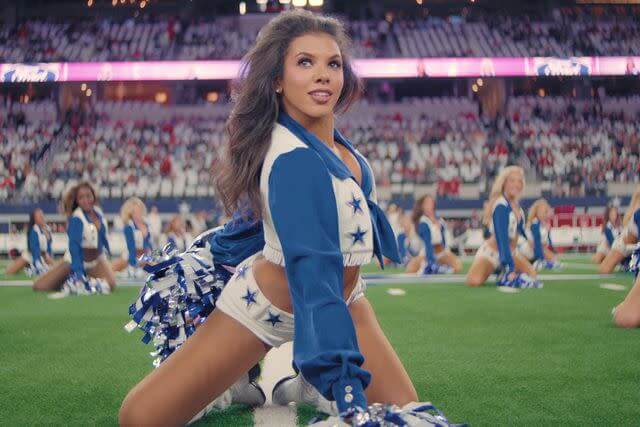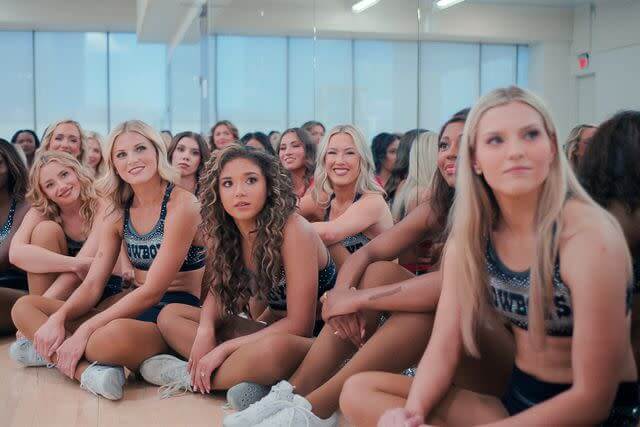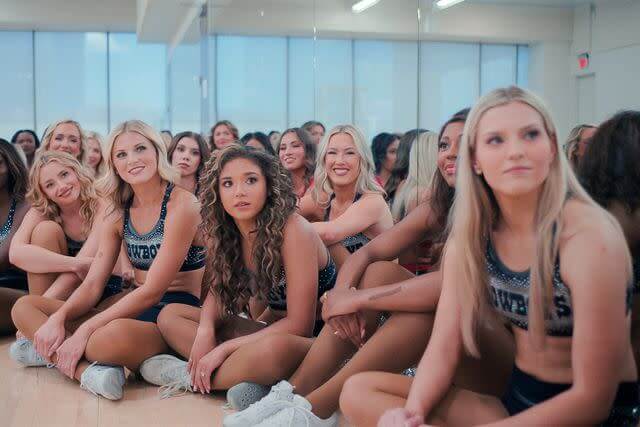Uncategorized
America’s Sweethearts: The Iconic Dallas Cowboys Cheerleaders
The Dallas Cowboys Cheerleaders (DCC) are more than just a team of dancers and performers. They represent a cultural phenomenon that has stood the test of time, shaping the world of cheerleading and becoming icons of pop culture. From their role as cheerleaders for the Dallas Cowboys to their presence in media, fashion, and entertainment, the DCC embody the spirit of the American football team, showcasing grace, talent, and determination. The cheerleaders’ journey, from their inception to their current global recognition, is a testament to their lasting legacy. This article will explore the history, impact, challenges, and future of the Dallas Cowboys Cheerleaders.
The Origins of the Dallas Cowboys Cheerleaders
The Dallas Cowboys Cheerleaders were formed in 1960, just one year after the team was established. However, it wasn’t until 1972 that the cheerleaders became a prominent fixture of the Cowboys’ brand, thanks to the vision of then-team owner, Tex Schramm. Prior to this, cheerleading squads were mainly composed of male cheerleaders or women performing more traditional routines. The DCC revolutionized the industry by becoming the first cheerleading squad to wear more revealing uniforms, which caught the public’s attention.
The squad’s transformation into a professional and glamorous group was a stroke of genius. In 1972, a former Dallas Cowboys player, Tex Schramm, and Coach Tom Landry decided that the cheerleaders should be more than just a side act. This decision led to a significant change in the cheerleading culture. In the early years, the Dallas Cowboys Cheerleaders, under the direction of Suzanne Mitchell, began their journey toward national recognition. The cheerleaders went from being a small, inconspicuous part of the football game to an integral part of the Cowboys’ identity, appearing at games, events, and even on TV shows.
The impact of the Dallas Cowboys Cheerleaders was immediate. By the mid-1970s, the cheerleaders were already a popular subject of admiration across the country. Their signature white boots, blue hot pants, and star-spangled uniforms became synonymous with American pride and femininity.

The Rise to Fame: America’s Sweethearts
The 1970s marked the golden age of the Dallas Cowboys Cheerleaders as they transcended sports and entered the realm of popular culture. One of the key moments in the rise of the DCC came in 1979 when the cheerleaders appeared on the cover of “Sports Illustrated.” The magazine cover solidified their place in mainstream media, making them a household name and cementing their status as America’s Sweethearts.
The early exposure on national platforms led to their appearance on television specials, variety shows, and even feature films. In 1979, they were featured in a made-for-TV special called “The Dallas Cowboys Cheerleaders” which was broadcast to millions of viewers. This special not only highlighted the cheerleaders’ routines but also showcased their behind-the-scenes lives, making them more relatable and human to the audience.
As the 1980s rolled in, the Dallas Cowboys Cheerleaders became synonymous with glamour and beauty. Their sparkling uniforms, impeccable choreography, and polished routines elevated them from just game-day performers to international celebrities. Their presence at Cowboys games became a must-see event, and millions of fans would flock to watch their performances.
Furthermore, their presence in pop culture was not limited to sports. They became the epitome of beauty and grace, and their influence was felt in the fashion industry. With the rise of fitness culture in the 1980s, the cheerleaders were admired not only for their performances but also for their athleticism and commitment to staying in top physical condition.
Challenges and Evolution: Overcoming Obstacles
While the Dallas Cowboys Cheerleaders have enjoyed decades of fame and success, their journey hasn’t been without its challenges. Throughout the years, the DCC has faced controversies and criticisms regarding their uniforms, public image, and the role of women in professional sports. One of the most significant challenges the squad has faced is the scrutiny over the sexualization of their uniforms. In the 1970s and 1980s, the DCC’s revealing outfits became a source of both admiration and controversy. Critics argued that the cheerleaders were being objectified, while supporters contended that they were empowering women by giving them a platform to showcase their athleticism and beauty.
The DCC’s leadership worked tirelessly to balance these concerns while maintaining the integrity of the team. In the 1990s, under the direction of Kelli Finglass, the cheerleaders adopted a more professional image. The team introduced more conservative uniforms while focusing on the dancers’ skill, professionalism, and fitness. This shift helped to address some of the controversies surrounding the squad while maintaining their status as a symbol of beauty and strength.
Beyond the public’s reaction to their image, the Dallas Cowboys Cheerleaders also faced internal struggles. Over the years, there have been numerous changes in leadership, competition, and team selection processes. The auditions for the DCC are infamous for being grueling and selective, requiring candidates to pass both physical fitness tests and intricate dance routines. Many hopefuls spend years auditioning before they make the final cut, and even once they’re chosen, their careers can be short-lived due to the intense pressure to maintain an ideal physique and perfect performance standards.
Despite the challenges, the DCC has continued to evolve, adapting to cultural shifts while maintaining the essence of what made them successful in the first place: their grace, athleticism, and undeniable charm.

The Role of the Dallas Cowboys Cheerleaders in Modern Culture
In the 21st century, the Dallas Cowboys Cheerleaders have remained an iconic symbol of American sports culture. However, their role in modern culture has expanded beyond the football field. The DCC is now involved in various philanthropic endeavors, charity events, and community outreach programs. They are known for their work with military families, children’s hospitals, and their support of other charitable organizations.
The cheerleaders’ social media presence has also helped them remain relevant in an increasingly digital world. With millions of followers across platforms like Instagram, Twitter, and TikTok, the Dallas Cowboys Cheerleaders have transformed into influencers, connecting with fans and offering a behind-the-scenes look at their lives. This presence allows fans to feel more connected to the squad, and it provides the cheerleaders with a platform to showcase their personal lives and professional achievements.
Additionally, the cheerleaders have expanded their reach through reality TV. “Dallas Cowboys Cheerleaders: Making the Team” has been airing since 2006, offering viewers a glimpse into the rigorous selection process, the daily lives of the cheerleaders, and the challenges they face to remain on the squad. The show has added another layer of accessibility to the DCC’s image, showing the public the hard work and dedication required to be a part of this prestigious team.
Through their continued participation in both traditional media and the digital realm, the Dallas Cowboys Cheerleaders have maintained their status as global icons, connecting with fans of all ages and backgrounds.
Looking Ahead: The Future of the Dallas Cowboys Cheerleaders
As the Dallas Cowboys Cheerleaders approach their 60th anniversary, their future remains as bright as ever. While the world of cheerleading has evolved, with other NFL teams following the lead of the Cowboys, the DCC still sets the standard for cheerleading squads across the country.
The future of the DCC will likely continue to reflect the changing dynamics of both sports and entertainment. The squad will likely embrace more diversity, not only in their appearance but also in their involvement with a broader range of sports and entertainment events. As fans become more socially conscious, the DCC may continue to explore ways to remain relevant by championing social causes and engaging with the next generation of fans in meaningful ways.
With the rise of women’s sports, the DCC could also find new ways to collaborate with other female athletic teams and organizations. Their commitment to health, fitness, and athleticism could play an even greater role in shaping how women’s sports are perceived in the years to come.
Despite these shifts, one thing is clear: the Dallas Cowboys Cheerleaders will continue to be an integral part of the NFL, the Dallas Cowboys franchise, and the world of cheerleading. Their legacy is secure, and as they continue to inspire new generations of fans, their place in history is firmly cemented.
Conclusion: A Lasting Legacy
The Dallas Cowboys Cheerleaders are more than just a squad of dancers; they represent a cultural phenomenon that has shaped the world of cheerleading and popular culture for decades. Their rise to fame, their resilience in the face of challenges, and their ability to adapt to changing times have cemented their place as one of the most iconic cheerleading squads in the world. As they continue to inspire and entertain, their legacy as “America’s Sweethearts” will remain a cornerstone of the Dallas Cowboys franchise for years to come.
From dragontrendtees


